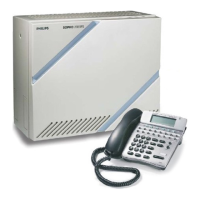– 205 – NWA-008845-001 Rev.5.0
32ch1004.fm
For non-DID on ISDN, Caller ID incoming calls:
(See SAMPLE DATA PROGRAMMING 2. Page 209)
NOTE 1: When a Called Party Subaddress is received from ISDN subscriber, CID Call Routing is not
effective.
NOTE 2: When you activate CID Call Routing for Caller ID trunk, do not assign CMDB Y=01, Y=02.
DESCRIPTION DATA
Provide the calling number development and
specify its Development Pattern for each trunk
route number.
NOTE: For DID on ISDN, T1-ANI, MFC
calls, this data is not effective and
the data setting of CM76 Y=26 is
effective.
•
(1)
(2)
Y=174
00-63: Trunk Route No.
0: To provide
(Using Development Pattern 0)
1: To provide
(Using Development Pattern 1)
2: To provide
(Using Development Pattern 2)
Assign the Development Block number for
each calling party number.
•
•
•
(1)
(2)
Y=50 Development Pattern 0 assigned by
CM35 Y=174
Y=51 Development Pattern 1 assigned by
CM35 Y=174
Y=52 Development Pattern 2 assigned by
CM35 Y=174
X-XX....XX: Calling Party No.
(Maximum 16 digits)
X: 0-9
000-999: Development Block No.
Select the two kinds of mode change or the
four kinds of mode change per each tenant.
•
(1)
(2)
Y=29
00-63: Tenant No.
0 : Two kinds of mode (Day Mode, Night
Mode)
1 : Four kinds of mode (Day Mode, Night
Mode, Mode A, Mode B)
Assign the station tenant for each calling party
number.
•
(1)
(2)
Y=09
000-999: Development Block No. assigned
by CM2A Y=50/51/52
00-63: Station Tenant No.
START
CM35
CM2A
CM65
CM76
A
CID CALL ROUTING

